Data is the key to leveraging call center analytics. You can't make data-driven decisions without access to clean, organized data.
Even though your contact center stores lots of analytics data, decoding it manually is highly complex and time-consuming. As a contact center manager, team leader, VP or quality trainer, reviewing call center analytics is one of the most time-consuming tasks you will face.
Call center leaders can easily get overwhelmed navigating mountains of data to identify performance gaps, agent training needs, and areas for improvement to boost productivity.
But not only call center leaders, agents are also flooded with data from customer interactions, post-call data, and other sources such as the CRM.
.png)
Making sense of the vast amount of contact center analytics data consumes precious time and resources. With artificial intelligence (AI), the processes have become much more sophisticated and mature.
Leveraging AI the right way takes care of the data aggregation and insights gathering while providing actionable intelligence in real time, enabling swift decision-making and driving productivity.
In this guide we'll discuss call center analytics in detail including the types of analytics generated by contact centers, and how you can leverage AI to automate insights from your call center analytics data.
Topics we're covering:
- What are call center analytics
- Types of call center analytics data
- Challenges of call center analytics
- Consequences of poor call center analytics data management
- How to analyze contact center analytics
- How AI optimizes your call center analytics data
- How to Amplify your call center analytics
For top call center analytics-driven performance tracking software, explore our Best Call Center Performance Management Software guide.
What are Call Center Analytics?
Call center analytics is the result of gathering, analyzing, and interpreting data generated in a contact center environment. This analysis helps call center teams gain insights into various operations aspects, including agent performance, customer satisfaction, call volume trends, service level adherence, and more.
Call center analytics primarily aims to unveil actionable insights from agent interactions that drive better decision-making, deeper comprehension of customer needs, and improved business processes through data-driven problem-solving.
Contact center analytics leverage data from diverse sources and communication channels, including:
It is a common misconception that call center productivity metrics and KPIs are 'call center analytics' but the two are distinct and used for different purposes.
What's the difference between Call Center Analytics and Call Center Metrics (KPIs)?
The main difference between Call Center Analytics and Call Center Metrics (KPIs) is Call Center Analytics focus on data inputs whereas KPIs focuses on data outputs.
It's a common misconception that call center analytics are the same as key performance indicators (KPIs) and metrics, the truth is far more complex. Call center productivity metrics like average handle time (AHT), call volume, customer satisfaction scores, and average hold time are the results, or outputs, of deep analytical processes. These productivity and performance metrics are derived from analytics but do not encompass the analytics themselves.
Call center analytics sources are the backbone of getting accurate productivity metrics.
Types of Call Center Analytics
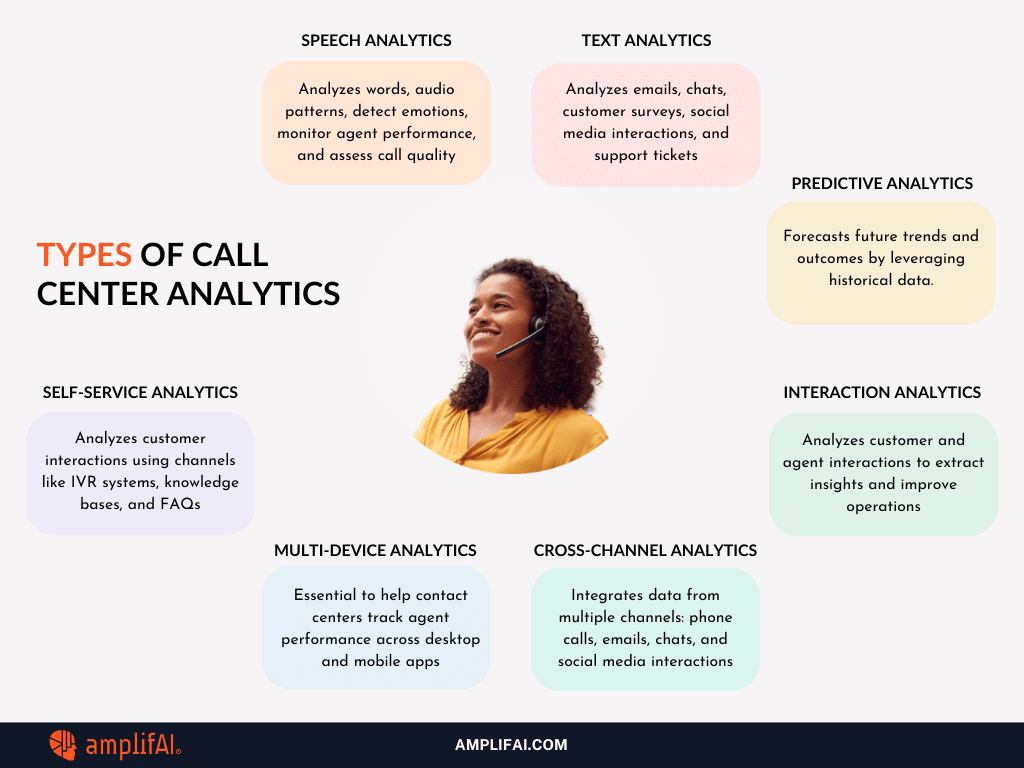
Each type of call center analytics data provides unique insights into different aspects of call center operations, customer interactions, and team performance. By leveraging these analytics effectively, you can improve efficiency, enhance customer satisfaction, and drive overall business success in your contact center.
7 Types of Call Center Analytics
Speech analytics involves leveraging AI to analyze recorded calls to extract valuable insights, including identifying words, analyzing audio patterns to detect emotions, monitoring agent performance, and assessing call quality.
According to McKinsey,
Speech analytics results in 20-30% cost savings and a 10% improvement in customer satisfaction scores.
Speech analytics comprises of:
With speech analytics, you can use the large number of conversations being stored and transform those into valuable insights that will benefit businesses by helping them discover trends, customer preferences, and opportunities for process improvement or training.
When analyzed correctly, speech analytics:
If you would like to learn more about how to get the most out of your speech analytics, check out our latest article: Speech Analytics: How it works
Text analytics analyzes written communications such as emails, chats, customer surveys, social media interactions, and support tickets to extract valuable insights and improve call center operations.
Text analytics provide insights into customer preferences, common issues, and opportunities for improving written communication strategies.
Here's how text analytics works and its applications:
Predictive analytics helps you forecast future trends and outcomes by leveraging historical data. In call centers, predictive analytics can forecast call volumes, staffing requirements, customer behavior, and potential issues.
Contact center analytics uses AI to analyze call center data and discover future trends and patterns to address or ignore potential issues..
Call centers can proactively adjust staffing levels, resources, and processes by anticipating future trends to meet demand and improve efficiency.
Predictive analytics applications:
Predictive analytics empowers call centers to make data-driven decisions, anticipate customer needs, optimize operations, and enhance customer experience.
Call center interaction analytics analyzes customer and agent interactions to extract insights and improve operations.
Contact centers can use AI, machine learning, natural language processing, and neural networks to identify customer preferences and pain points.
Interaction analytics allows you to recognize recurring issues or dissatisfaction areas and work on improving overall customer satisfaction. It helps improve first call resolution (FCR) by identifying factors leading to repeated calls for the same issue, which enhances FCR rates.
Desktop analytics track the performance and movement of contact center agents using desktop computers. Meanwhile, mobile analytics monitors mobile devices, such as tablets and smartphones.
Together, desktop and mobile analytics help you address slow bandwidth and security weaknesses. Teams can also monitor call center agents' apps and tools and whether they use them correctly.
They also help with real-time call monitoring by capturing inefficiencies, enhancing security, and identifying coaching opportunities for phone agents. This analysis can uncover redundant tasks, reduce call handling time, and improve overall efficiency, benefiting agents and customers.
Cross-channel analytics integrates data from multiple communication channels, such as phone calls, emails, chats, and social media interactions, giving a comprehensive view of customer calls and behavior across all touchpoints.
A call center must identify its customers' preferred channels and customize service accordingly. This helps them equip phone agents with this data, allowing personalized interactions.
For instance, if a customer primarily conducts banking online, agents can be alerted in real-time to offer online solutions. Just as with speech analytics, this area is emerging but likely to become indispensable in the future.
Cross-channel analytics help identify customer preferences, trends, and issues that span multiple channels, enabling call centers to deliver a seamless omnichannel experience.
Self-service analytics analyzes customer interactions using channels like IVR systems, knowledge bases, and FAQs.
Contact centers are now exploring methods to encourage self-service channels. For instance, if customers contact a call center agent to update their address, why not provide an online option on your website?
This helps minimize errors, decreases incoming call volumes, and reduces company costs.
Self-service analytics help optimize self-service channels, improve usability, and reduce call volumes by empowering customers to find answers and resolve issues independently.
Challenges of Call Center Analytics
Sometimes, too much of a good thing can become overwhelming, especially when it's not utilized effectively. This is the paradox of call center analytics: there's an abundance of data but too little time and too few resources to make sense of it and turn it into actual and measurable performance indicators.
.png)
Disjointed and siloed contact center analytics data hinders the effectiveness of call center operations and overall performance.
5 common call center analytics challenges
Consequences of Poor Call Center Analytics Management
When the wealth of data available isn't harnessed correctly, the fallout extends far beyond inefficiency.
Top 4 Consequences Include:
How to Manually Analyze Call Center Analytics
.png)
Following the 8 steps below, you can analyze your call center analytics data to drive continuous improvement and deliver better customer experiences.
8 Steps to Analyze Contact Center Analytics
How AI Optimizes Your Call Center Analytics Data
We've established that managing the vast amounts of data and analytics generated daily in call centers can be overwhelming, leading to missed opportunities and financial losses.
But with the right application of AI, this flood of data can be transformed into a powerful asset, boosting overall call center productivity and enhancing service delivery.
Here are some examples of how contact centers leverage analytics and AI to optimize operations:
- Get actionable insights
- Predict call load and agent’s performance
- Enhance customer satisfaction
- Boost automation and efficiency
- Provide the right coaching opportunities
AmplifAI Your Call Center Analytics
Using the power of AmplifAI to manage and interpret call center analytics can move your team from data overload to strategic action.
AmplifAI, is a comprehensive call center performance management software designed to integrate and synthesize data from all your contact centers analytics sources in real-time.
From cloud CRM platforms, in-house QA tools, homegrown apps to Excel files, AmplifAI integrates a diverse range of contact center data sources across speech analytics, text analytics, predictive analytics, interaction analytics-all of your call center analytics.
By consolidating these data sources through AmplifAI's patented data integration process, Gen AI transforms your complex datasets into clear, actionable insights, enabling contact center leaders to focus on effectively coaching their frontline team.
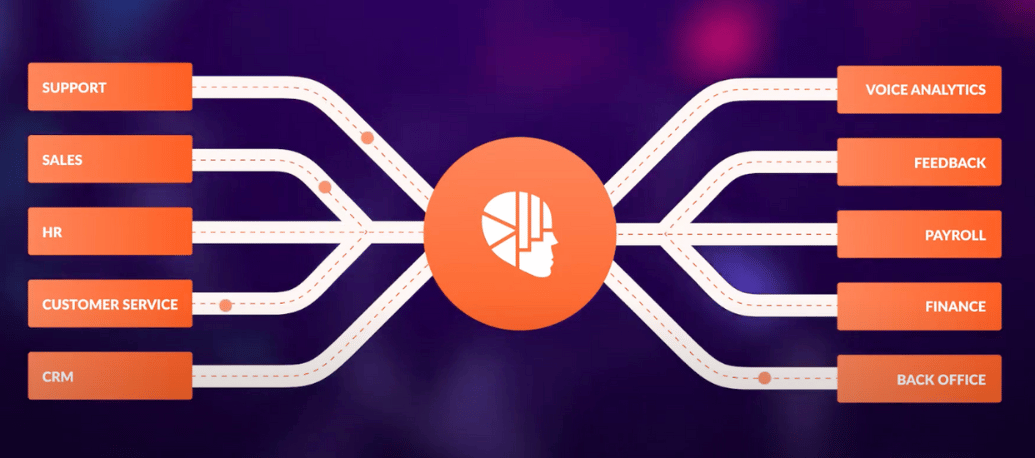
AmplifAI eliminates the effort of managing and analyzing all reports and automatically consolidates and visualizes all the complex contact center data with ease to give insights that will help maximize agent productivity.
AmplifAI is user-friendly and doesn’t depend on the IT teams. Once the data is ingested into AmplifAI a unified role based performance management dashboard gives real-time strategies to improve the metrics that matter most to your contact center.
How AmplifAI Unifies Your Call Center Analytics Data
.png)
Integration Across Systems
AmplifAI connects with over 150 leading call center technologies, ensuring that data integration is smooth and comprehensive, spanning from cloud systems to on-premise applications. This integration is handled with minimal input from IT teams.
Unified Role Based Dashboard
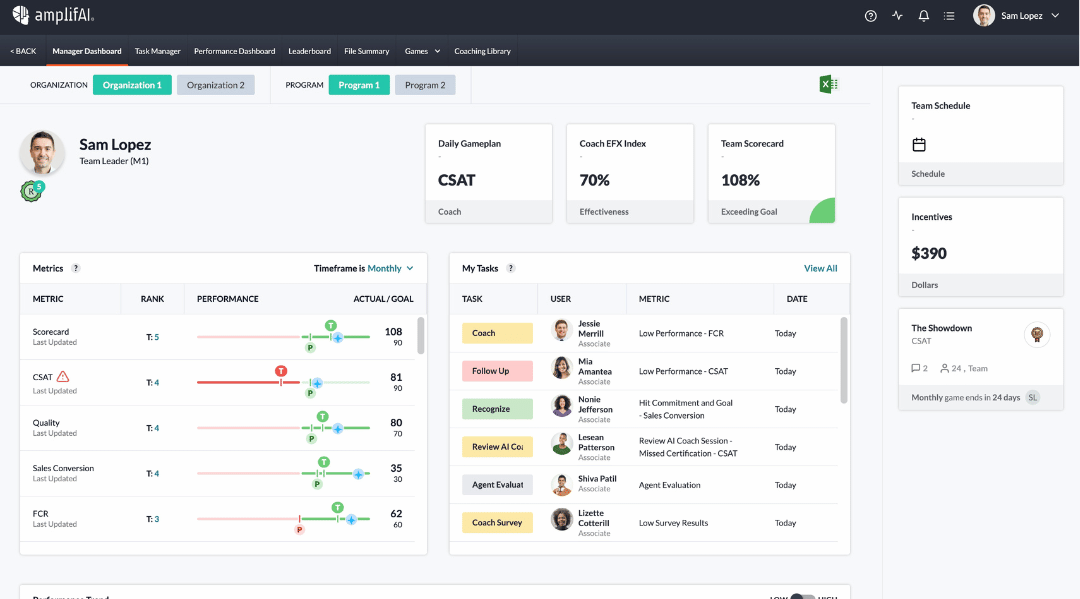
Once your call center analytics data is integrated, AmplifAI's Generative AI and LLM interprets it to provide real-time insights, next best actions, and real time actionable recommendations.
Data-Driven Coaching and Performance Management
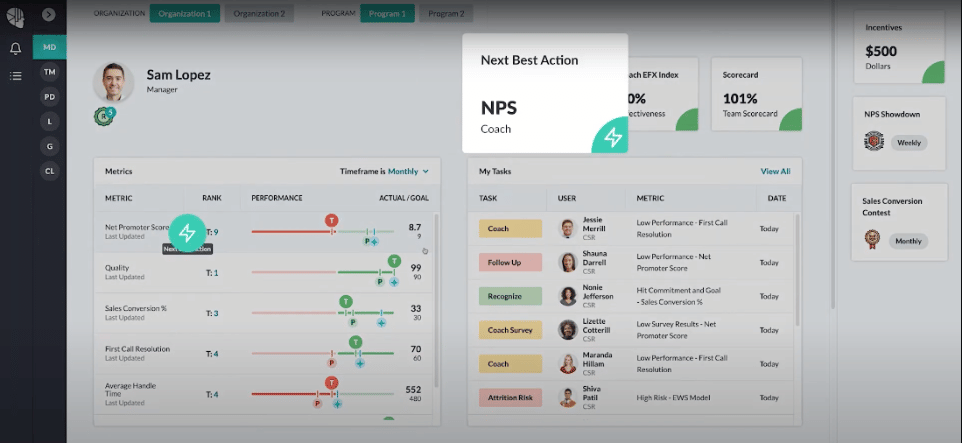
AmplifAI simplifies the process of effective call center coaching. By analyzing call center analytics across your team in real-time, AmplifAI identifies patterns creating high performer personas, using these insights to guide next-best-action strategies, coaching and development initiatives are tailored to boost the productivity metrics of all agents and team leaders in your contact center.
Agent Engagement and Recognition
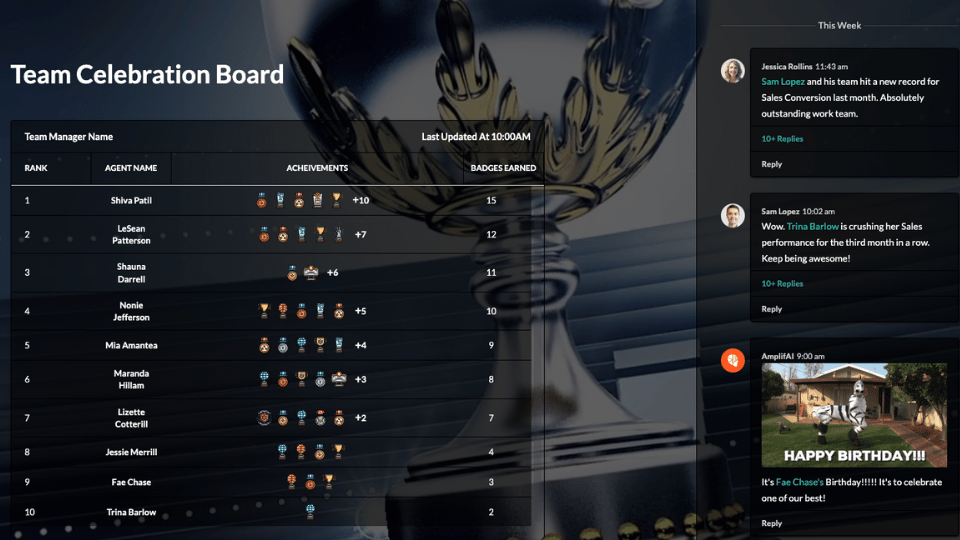
AmplifAI uses your real time call center analytics data giving team leaders the gamification and recognition tools to motivate agents in real time.
Automated Quality Assurance & Compliance
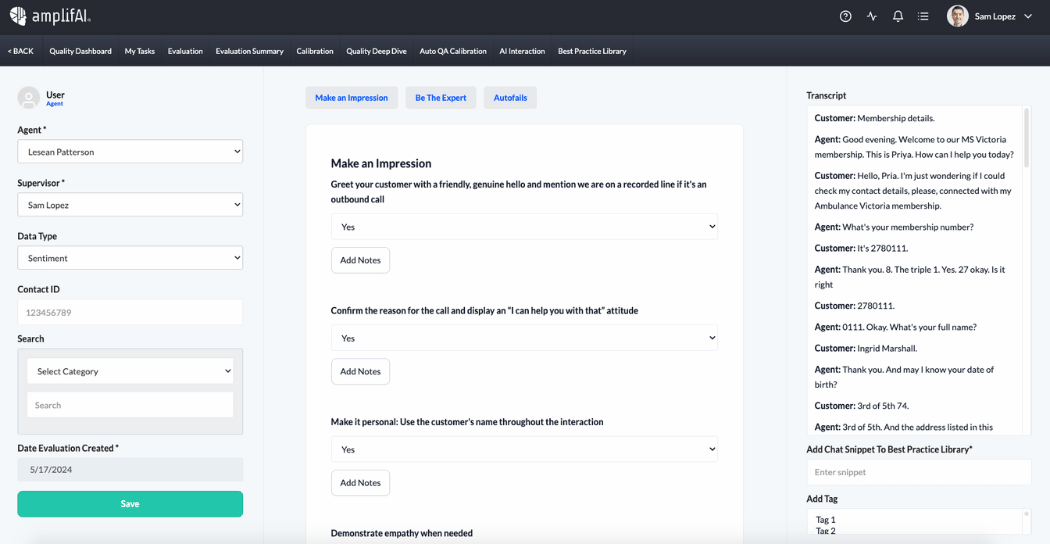
AmplifAI's call center quality assurance software automates the evaluation of agent interactions against QA benchmarks and goes a step further to tie this data into the specific and measurable performance metrics that matter to your contact center. This automation minimizes the need for tedious manual reviews and extracts valuable QA related information from your data.
Conclusion
In customer service, call center analytics is a vital strategic asset that impacts essential decisions in every aspect of the organization (from operations to coaching).
By leveraging call center analytics with AI you can unify your entire contact center while removing the burdens of data gathering, analysis, and forming insights. Seamlessly convert customer interactions into opportunities for enhanced growth, operational efficiency, and exceptional service delivery.
Schedule a demo to see how AmplifAI'ed brands are leveraging their contact center analytics data.
Looking for More Ways to Go From Analytics, Insights to Actions?
If you’re serious about optimizing your call center, these expert-reviewed guides will help you find the best software for every aspect of performance, coaching, and quality assurance.
Want the Best Contact Center Performance Management Software?
👉 Check out our expert-reviewed list of the 12 Best Call Center Performance Management Software of 2025.
Want the Best Contact Center Gamification Software?
👉 Check out our expert-reviewed list of the 7 Best Call Center Gamification Software of 2025.
Want the Best Contact Center Quality Assurance Software?
👉 Check out our expert-reviewed list of the 11 Best Call Center Quality Assurance Software of 2025.
Want the Best Call Center Coaching Software?
👉 Check out our expert-reviewed list of the 9 Best Call Center Coaching Software of 2025.


.png)
 Transcriptions of voice calls
Transcriptions of voice calls




.svg)


.svg)